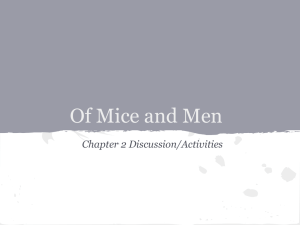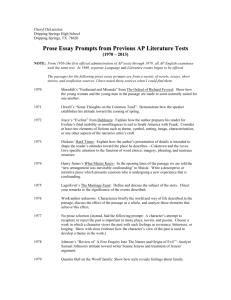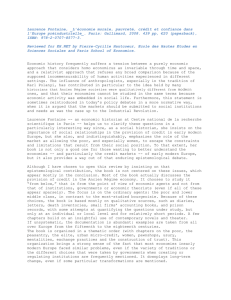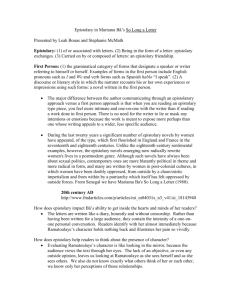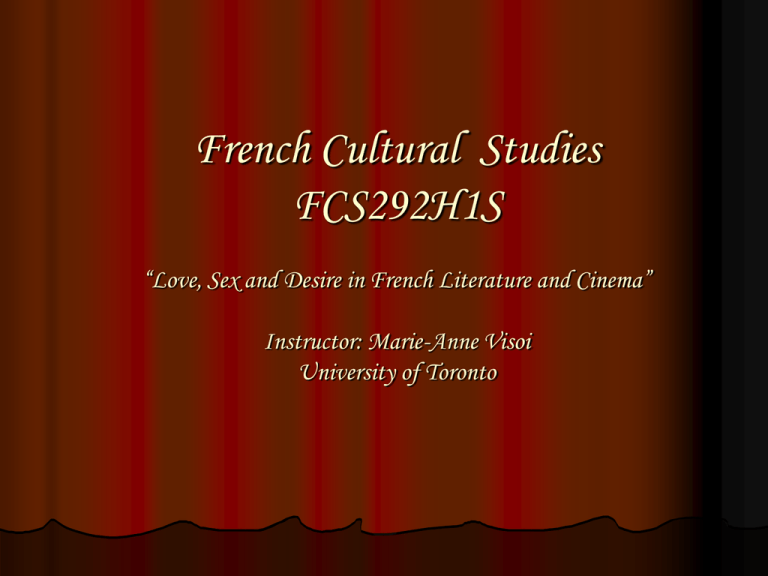
French Cultural Studies
FCS292H1S
“Love, Sex and Desire in French Literature and Cinema”
Instructor: Marie-Anne Visoi
University of Toronto
Pierre Choderlos de Laclos
“Dangerous Liaisons”
1782
Ancien Régime (“former regime”,“old order”)
term coined by the French Revolutionaries to promote
a new cause and discredit the existing order
refers primarily to the aristocratic social and political
system established in France under the Valois and
Bourbon dynasties (14th century to 18th century)
power in the Ancien Régime relied on three pillars:
the monarchy, the clergy and the aristocracy
18th Century France
Enlightenment
French thinkers proposed a series of social, economic, political,
religious, and educational reforms.
Montesquieu, “Lettres persanes”, 1721
criticized the lifestyle and the liberties of the
aristocracy
Voltaire, “Candide”, 1759; “Lettres philosophiques sur
les Anglais”, 1733
denounced the hypocrisy of the “ancien régime”
believed in the idea of an “enlightened” monarch who
can bring about needed changes
Diderot, editor of “L'Encyclopédie”1751-1772;
“Pensées sur l'interprétation de la nature”,1754
“Jacques le fataliste”, 1770
reflected on the relationship between the individual
and society
believed that right reason, or rationalism, could find
true knowledge and lead mankind to progress and
happiness
Rousseau, “Julie ou la Nouvelle Héloïse”, 1761
(epistolary novel)
“Du contrat social”, 1762
the central concept is “liberty”: the mutual contract
between the authorities and the governed implies that
the governed agree to be ruled only so that their
rights, property and happiness be protected by their
rulers. Once rulers cease to protect the ruled, the social
contract is broken
"Man is born free but everywhere is in chains."
The European Novel
Cervantes, “Don Quixote”, 1605
Madame de La Fayette, “La Princesse de Clèves”, 1678
Richardson, “Pamela”, 1740; “Clarissa”,1749
Sterne, “Tristam Shandy”, 1760-67
Goethe , “The Sorrows of Young Werther”,1774
new and sensational stories
invited heightened emotional response to events
recounted
Epistolary Novels
popular genre in the 18th century: the narrative is
told in letters by one or more characters
the claim of “authenticity” adds verisimilitude to the
story
allows multiple points of view; presents feelings and
reactions of characters
characters reveal their personalities through what
they write
“Dangerous Liaisons”
Epistolary novel: 175 letters
Date of publication: 1782
Setting (time and place)
• the letters are written between the months of
August and January 17**
• a novel of interiors: aristocratic “chateaux”
Foreshadowing
(“Publisher’s note”; “The Editor’s Preface”)
De Laclos manipulates the reader through the
use of two “metatexts”
provides a sense of foreboding, anticipates
events
“The Editor’s Preface”
De Laclos presents the view that only “a small
portion of the correspondence” was arranged
chronologically
claims that the letters are “authentic” and that the
language of the letters has not been edited because
”the intention was to publish the letters themselves
and not a literary work”
the “editor” points out the didactic nature of the
work
Narration
novel starts in “media res” (in the middle of things):
flashbacks to what happened in the past
absence of an “omniscient narrator”
multiple narrators; main correspondence is between
Marquise de Merteuil and Vicomte de Valmont
De Laclos offers different points of view on identical
events through sequencing of letters
complex plot
Love, sex and desire in the novel
“negotiation” of desire through letter writing
conception of love: aristocratic model of military
conquest versus naïve, romantic love
aristocratic values versus “bourgeois” values
models of sexual conquests
sexual corruption
portraits of the male and female “libertine”
Merteuil-Valmont relationship remains spiritual
(courtship through letter-writing)
Merteuil’s constant struggle to control “desire” and
seduce through writing: describes intimate scenes,
provokes Valmont by promising sexual rewards
Art of seduction in the “ancien régime”
the art of seduction was held in high esteem: courtly
love, erotic games
perversion: many lovers, loose morals
erotic games were played in order to intensify desire
sex was not considered as important; once the sexual
intercourse took place, women knew that men might
lose their interest
How to analyze a literary passage?
Read or re-read the text with specific questions in mind.
Identify basic ideas, events and names. Depending on
the complexity of the book, this requires additional
review of the text.
Think through your personal reaction to the book:
identification, enjoyment, significance, application.
Identify and consider the most important ideas.
Return to the text to locate specific evidence and
passages related to the major ideas discussed in class.
Discuss what happens in the passage and why it is
significant to the work as a whole.
Consider what is said, particularly subtleties of the
imagery and the ideas expressed.
Assess how it is said, considering how the word choice,
the ordering of ideas, sentence structure, etc.,
contribute to the meaning of the passage.
Explain what it means, tying your analysis of the
passage back to the significance of the text as a
whole.
Repeat the process of context, quotation and analysis
with additional support for your arguments.
“Dangerous Liaisons”
Passage Analysis
Read Letter 1, page 11
Discuss:
• characters
• what happens in the passage
• why is the letter significant to the work as a whole
• word-choice, style, content of letter
• your own reaction to the passage
The UVic Writer's Guide
Literary Terminology
Writing a Literary Essay
http://web.uvic.ca/wguide/Pages/MasterToc.html#Literary Terms Alpha








